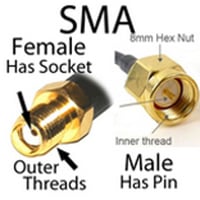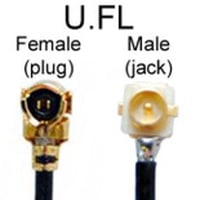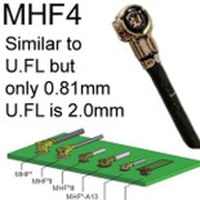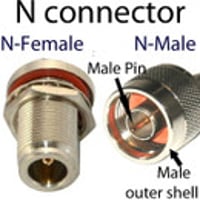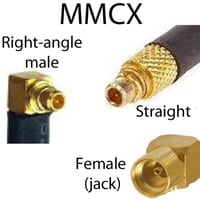Antennas with SMA Connector
SMA Antennas
SMA was the connector of choice for most applications until RP-SMA began to replace SMA in the late 1990s, as the more popular option, Therefore there are far more RP-SMA antenna options than SMA antenna options: We have many SMA to RP_SMA antenna cable and adapter options that enable you to connect an RP-SMA antenna to an SMA cable or connector. .
Data Alliance offers SMA antennas for WiFi, LTE, GSM, CDMA, Bluetooth, base stations, radio astronomy, hand-held radios or telephones, machine-to-machine communications. A 433MHz antenna is also likely to be an SMA antenna.
SMA antenna and coax connectors feature 50 Ohm impedance, drawing DC from 0GHz up to 18GHz.
SMA connectors have a relatively durable screw coupling (good for 500 couplings at recommended torque) and are resistance to vibration. They are also cost-effective when designed in gold-plated brass, nickel-plated brass, or stainless steel.
The male connector features a central pin coated with nickel or gold. The barrel screws on to an SMA female antenna or coax with threading spaced at 36 threads per inch. The female connector has a central receptacle for the pin, also coated with nickel or gold, the threads external to the outer casing. Both connectors are insulated with polytetratluoroethylene (PTFE) dialectric.
An antenna with an SMA connector couples to an SMA cable: RF coaxial antenna cable shielded to prevent signal degradation. RF coax cables cannot be stripped and soldered together without signal loss. The SMA connector is one of several RF connector designs to connect coaxial cables and antennas while preserving the signal.
SubMiniature Version A (SMA) is an RF coaxial connector designed for semi-precision applications. Visually it is similar to the common household 75 Ohm Type F connector that screws into cable boxes, the design varies by 2mm and the two cables cannot b connected without an adapter
SMA antennas are a diverse group of radio frequency antennas that possess an SMA connector for attachment to a coaxial extension cable or other radio frequency hardware. An SMA connector serves as the primary channel through which radio frequency signals can flow between the antenna and the device it is attached to. These antennas are capable of intercepting electromagnetic energy and translating it into electrical current and vice versa. They are designed to connect by soldering or crimping to semi-rigid coaxial cable. This widely used and hard-wearing connector is the primary point of connection for the antenna and may even have to provide mechanical and structural support as part of an antenna's design. A single SMA connector may be installed on an antenna, or additional auxiliary SMA connectors may be present, to support antenna diversity as we discuss further on. In this case, the type or class of antenna and its applications can vary widely but the consistent feature is the SMA connector used in the antenna.
Applications of SMA Antennas
The applications of the SMA antenna are determined largely by the applications in which the SMA connector excels. Though initially developed for the defense, aerospace, radio astronomy, and Testing and Measurement sectors, the SMA connector has become much more prevalent in use in cellular telecommunications, radio navigation (including GPS), and wireless networking. For its more contemporary and civilian-focused applications, SMA antennas are typically used at sub-6 GHz frequencies.
-
Wireless Communication Backbone Systems: SMA connectors are frequently used in wireless communication systems, such as Wi-Fi routers, cellular devices, and Bluetooth devices. SMA antennas are often used for signal reception and transmission in these applications.
-
IoT Devices and Gateways: In Internet of Things (IoT) gateways and hubs, SMA connectors enable the connection of external antennas for improved signal strength and coverage. IoT devices often have a MMCX, U.FL, or MHF4 connector or jack on the Printed Circuit Board (PCB): As an adapter to make this connection, an SMA antenna would connect to the jack via an SMA to MMCX cable, SMA to U.FL cable, or SMA to MHF4 cable.
-
Industrial IoT: SMA connectors are used in various industrial applications and Internet of Things (IoT) devices for wireless data transmission and sensor connectivity.
-
GPS Antennas: SMA connectors are used in GPS (Global Positioning System) antennas, which are widely used in navigation systems for accurate positioning and location-based services.
-
Satellite Communication: SMA connectors can be found in satellite communication systems, including satellite dish antennas and satellite modem equipment.
-
Drones and UAVs: SMA connectors are used in drones and unmanned aerial vehicles (UAVs) for video and telemetry transmission, as well as for GPS and other communication systems.
-
Wireless Surveillance Systems: SMA connectors are utilized in wireless surveillance systems, such as security cameras and video transmitters, to transmit video and audio signals wirelessly.
-
Amateur Radio: Amateur radio operators often use antennas with SMA connectors for various applications, including portable and mobile ham radio setups.
-
Medical Devices: SMA connectors can be found in medical devices like patient monitoring equipment and medical telemetry devices for wireless data transmission.
-
Automotive: SMA connectors are used in automotive applications for wireless communication systems, including vehicle-to-vehicle (V2V) and vehicle-to-infrastructure (V2I) communication.
-
Research and Development: In research and development environments, SMA connectors are used for prototype development, testing, and experimentation in a wide range of scientific and engineering disciplines.
-
Aerospace and Defense: SMA connectors are used in aerospace and defense applications, including radar systems, electronic warfare, and communication equipment.
-
Custom Electronics: SMA connectors are sometimes used in custom electronic projects and DIY electronics for connecting external antennas to PCBs or modules.
Applications based on Special Features of SMA Antennas
Antenna Swapping
SMA connectors allow for easy swapping of antennas, which is useful in scenarios where signal propagation conditions change, such as in outdoor activities, camping, or fieldwork.
RF Testing and Measurement
SMA connectors are commonly used in RF testing and measurement equipment like spectrum analyzers, network analyzers, and oscilloscopes. SMA antennas and connectors allow for precise and reliable signal measurement.
The SMA connector
The letters SMA stand for sub-miniature version A and describes the SMA connector dimensions and caliber of this connector according to its original US Military (MIL) SMA connector specifications, outlined in MIL-C-39012. It was developed in the 1960s by the Bendix Scintilla and Omni Spectra Corporations, both US-based engineering companies. SMA connectors are:
- Sub-miniature - a smaller radio frequency connector class designed to perform in small spaces. The male connector has a diameter of 7⁄16 inch (11 mm), and the female's diameter is 3⁄8 in (9.5 mm).
- Semi-precision - the SMA connector is designed and manufactured in line with its specification to an accuracy of 1/64th of an inch.
- Threaded - the SMA connector is coupled via a screwing mechanism with 36 threads per inch on each connector.
Additional physical features include:
- A male plug that has internalized threads and center pin conductor surrounded by an insulator.
- A smaller diameter SMA female jack that has externalized screws and inner mating interface with the center receptacle.
- A 5/16 inch hex nut on the male, that is used to tighten the coupled connector with a special wrench.
SMA antennas can carry either a male or female connector that is coupled to its complementary part by screwing the male part over the female. An sma connector wrench is then used to tighten the connector to the appropriate level of torque. When appropriately tightened, the connection of an SMA antenna should be waterproof, resilient against movement and vibration, and secure, being rated for up to 500 mating cycles. This makes the SMA connector an ideal termination for antennas that may be used in a range of environments. The SMA antenna connector is usually made from either brass (which may be gold or nickel-plated) or steel. The mating interface contains a copper-plated inner pin or receptacle which is surrounded by a PTFE insulator. The SMA connector also comes in a range of formats, such as right-angled and bulkhead SMA connectors which facilitate all sorts of mounting and installation arrangements for SMA antennas. On individual SMA antennas, the connector may be recessed, rotating, or articulating to increase the utility of a particular antenna. As it is small and lightweight it adds little to the weight and profile of the antenna despite being very secure.
SMA antenna characteristics
Aside from the connector specifications, SMA antennas will have fundamental characteristics that will determine how it operates within a radio frequency circuit. The following basic features should be carefully evaluated to ensure optimal performance.
- Frequency: the portion of the radio spectrum at which the antenna becomes resonant. Some antennas operate at a specific frequency, others are multi-band antennas which are particularly useful for cellular communication.
- Bandwidth: the range of frequencies over which the antenna will perform as specified.
- Directivity: whether or not the antenna radiates or receives a greater portion of electromagnetic energy in a specific direction. This usually differentiates directional SMA antennas, which focus electromagnetic energy in a specific direction, from omnidirectional SMA antennas, that radiate or receive energy equally in all directions perpendicular to the antenna's axis.
- Gain: essentially the antenna's use of input power to radiate electromagnetic energy.
- Radiation pattern: a graphical two or three-dimensional representation of how an antenna radiates or receives electromagnetic energy.
- Polarization: refers to the orientation of electromagnetic waves as they radiate from or are received by an antenna and can be:
- horizontal
- vertical
- elliptical
- circular
Key types of SMA antennas
[A] Cellular SMA antennas
The SMA connector is recognized as standard output for cellular antennas. They cover the key cellular technologies including:
- GSM: Global System for Mobile Communications, a telecommunications standard that is also known as 2G. It has worldwide coverage and is still in widespread use. Depending on the geographic region the carrier frequency will vary, usually within the 850-900 or 1800-1900 MHz bands so the antenna GSM users purchase will need to be compatible.
- Universal Mobile Telecommunications System (UMTS): is a third-generation standard for cellular communication based on GSM that uses wideband radio access technology to provide bandwidth to operators. It also operates at a range of frequencies, notably the 850 MHz band and the 2100 MHz band (both of which are licensed), and is known to support international roaming where devices are compatible.
- 3G: Third generation cellular telecommunication technology superseded the 2.5G standard, providing faster data transfer rates and more secure operation. It is compliant with specifications (IMT-2000) devised by the International Telecommunication Union.
Its higher data transfer rates mean that in addition to voice telephony, 3G can support wireless and mobile internet access, mobile TV, and video calling. - LTE: also known as Long Term Evolution is a wireless broadband standard devised by the Third Generation Partnership Project (3GPP) to provide a path for progression or upgrade of GSM and UTE technologies, increasing their capacity and data rates. LTE uses a range of novel digital signal processing and modulation techniques and frequency bands. It has some similarities to 4G but remains distinct.
A SMA connector antenna can be used with a cellular antenna cable for cellular network infrastructure or as signal boosters, in areas where cellular coverage is poor. They are a key last-mile solution for remote areas where little cellular infrastructure is present or for temporary deployment. A SMA cellular antenna can help overcome some of the limitations encountered with mobile communication including:
- Frequent disconnection or loss of signal
- Variable latency
- Inconsistent speeds
- Inability to utilize VoIP or mobile internet
Cellular antennas or cellular repeaters usually consist of an outdoor donor antenna which feeds the signal to a secondary antenna, installed indoors where coverage is required. These wideband or multiband SMA antennas can be used as vehicle-mounted cell phone signal boosters and may be single or multiband antennas depending on requirements.
[B] GPS SMA antennas
Global Navigational Satellite Systems, like the Global Positioning System, are reliant on sensitive, resonant antennas with good exposure to the open skies. This is because these radio navigation systems acquire their data from a constellation of orbiting satellites that continually broadcast time, status, and positional data. Ideally, four satellites are needed to facilitate a 'fix' on a GPS receiver. This signal is captured by a GPS antenna, amplified, and then used by GPS devices for location, tracking, and navigation functions. SMA connectors are a common feature on external GPS antennas, that can be optimally positioned using through-hole mounting, magnetic mounting, or extension cables. GPS antennas can also be paired via a GPS antenna connector with LTE antennas for enhanced performance.
[C] 2.4 GHz SMA antennas
The 2.4 GHz frequency band is an unlicensed Industrial Scientific and Medical (ISM) band that has been appropriated for a wide range of wireless technologies, many of which are consumer-facing such as:
- WiFi
- Bluetooth
- ZigBee
Wireless local area networking and personal area networking may require external antennas to enhance signal coverage. In contemporary domestic settings, a range of consumer products and devices use this frequency like wireless baby monitors, cordless phones, drones, closed-circuit television, printers, keyboards, headphones, and speakers. This is because certain environments, like built-up areas or inside buildings, can cause reflections, refraction, and multipath interference at this frequency. At 2.4GHz signal penetration through walls and materials like concrete can be variable. External SMA antennas can be used in setting up an optimized network that makes the most use of routers or wireless access points. SMA dual-band antennas can support both 2.4 and 5 GHz WiFi. If you are purchasing an SMA antenna for a WiFi application it is prudent to check connector compatibility as many WiFi routers utilize Reverse Polarity SMA connectors. These connectors appear similar to SMA connectors but are incompatible. More on this below.
[D] MIMO antennas with SMA connector
MIMO stands for multiple-input and multiple-output and refers to a type of spatial diversity where radio link capacity and spectral efficiency is increased by multiplying the number of antennas transmitting and receiving the same signal. This technique takes advantage of multipath between antennas and overall leads to faster propagation and increased throughput of data.
SMA antennas are frequently used for multi-antenna setups.
SMA antennas can be used to create wireless diversity schemes like antenna diversity or spatial diversity. Like MIMO, this technique uses paired antennas to strengthen a wireless link. It is particularly useful in environments where line of sight between transmitting and receiving antennas is absent relying on multipath to propagate the signal instead. Multiple antennas transmitting and receiving on the same frequency provide several observations of the transmitted signal and increases the opportunity for the transmitted data to be accurately recovered.
Why are SMA antennas important?
SMA antennas are in widespread use in industry, network infrastructure, commercial and consumer use. Over the past 50 years, this versatile screw-down connector has become established as a reliable choice for secure and high-performance wireless communications, particularly in cellular networks and so SMA antennas are continually produced with this connector to meet ongoing demand and maintain compatibility with existing radio frequency hardware.
The selection of an SMA antenna is a discerning one and careful evaluation of both the antenna type and the suitability of an SMA connector will prevent device failure due to the incompatibility of the antenna or failure of the connection, especially if the connector is also the sole attachment point for the antenna. A high-quality SMA connector will help safeguard the performance and longevity of the attached antenna and prevent inopportune signal loss, which can be hazardous if, for example, the antenna is being used by the emergency services or for navigation.
The SMA connector provides not only a physical but electrical match for the antenna and downstream cabling or electronics. These microwave connectors are impedance matched and have the 50-ohm impedance necessary for most radio frequency circuits. A properly matched connector means that radio frequency signals conducted by the antenna will not be affected by step changes or discontinuities that cause reflections, multipath, and ultimately signal interference. The applications in which SMA antennas are used, typically involve microwave or sub microwave frequencies. As the SMA connector:
- Has a frequency range of DC to 18 GHz,
- Is tolerant of voltages up to 300 volts,
- Has maximum radio frequency leakage of -60 dB
It can handle high frequency and high voltage applications with limited attenuation, making SMA antennas well suited to the wide range of wireless applications shared below.
Frequently asked questions
Are SMA antenna connectors and RP-SMA connectors the same?
No. You will find that though SMA connectors and RP-SMA connectors may be able to be screwed together, they are unable to make an electrical connection. This is because RP-SMA or reverse polarity connectors are a distinct variant of the standard SMA connector. RP-SMA connectors have a deliberate reversal of the genders of the inner mating interface. This was originally done to prevent amateur or non-professional connection of high gain antennas to devices, in line with FCC guidance to prevent their illicit use. In reverse SMA connectors, the male pin is switched over to the female jack and the female inner receptacle is found instead on the male plug. This means that the mating interfaces of SMA and RP-SMA connectors are incompatible as you end up with either two pins or two plugs. A SMA converter can be used so that an SMA antenna can be used with an RP-SMA extension cable.
What does the AUX antenna output do?
Many cellular antennas carry an SMA connector auxiliary output which is supplied to enable the antenna to be paired with a second identical or compatible antenna. This is done simply by attaching a high-quality SMA extension cable to join the antennas. In this arrangement, there will be a main antenna which is capable of transmitting and receiving and an auxiliary antenna which can only receive signal. This simple diversity arrangement is a requirement for LTE connectivity. A GPS antenna can also be connected to an LTE antenna for mutual signal enhancement.
How far away can my cellular antenna be from a cell phone tower?
If you are looking for remote 3G/4G connectivity it is important to know that cell towers do enforce a maximum range which cannot be overcome by using a higher gain antenna, even with line of sight. Normal cell range is between 2 and 7 miles (3.2 to 11.2 kilometers). A cellular tower will measure the round trip time between itself and the antenna. If this time is prolonged the downstream antenna will automatically be considered out of range.
In conclusion
SMA antennas are a heterogeneous group, but all benefit from the robust physical and electrical profile of the SMA connector. The use of this widespread connector makes creating networking solutions easier as connectors, adapters and coaxial cables are readily sourced and provide consistent performance. SMA antennas are particularly known for their applications within cellular networking and can be readily paired with like or alternate antenna classes for improved performance.
LEARN MORE:

